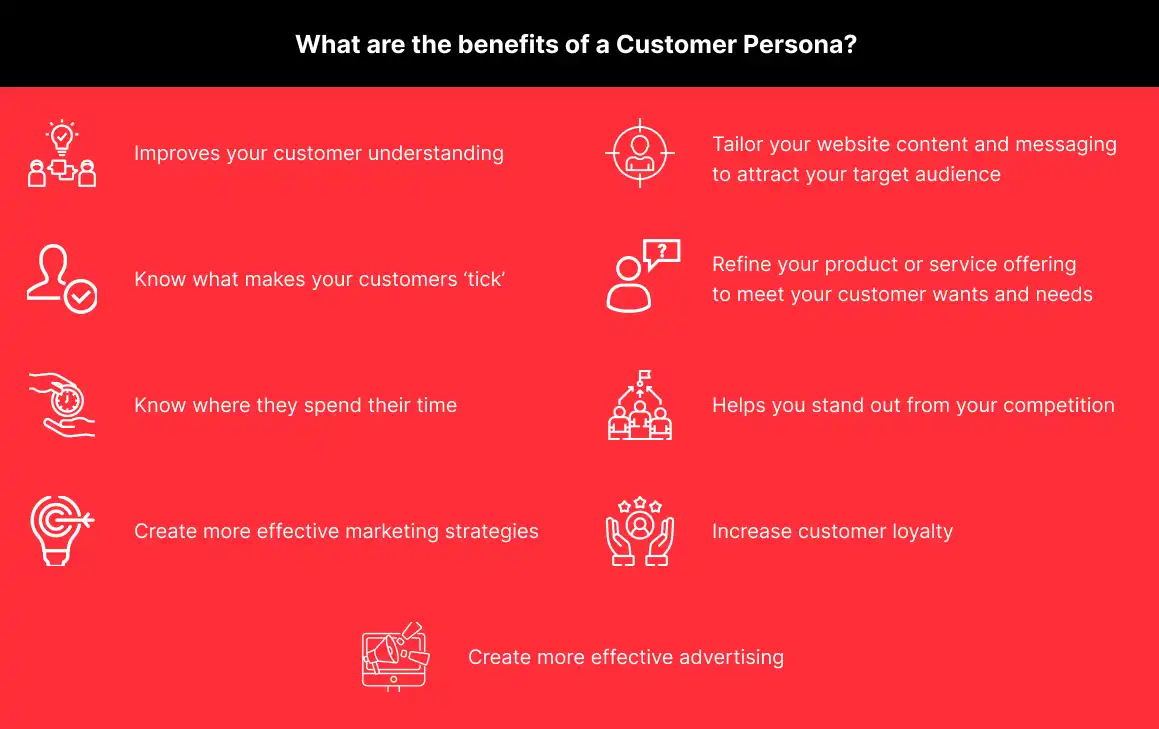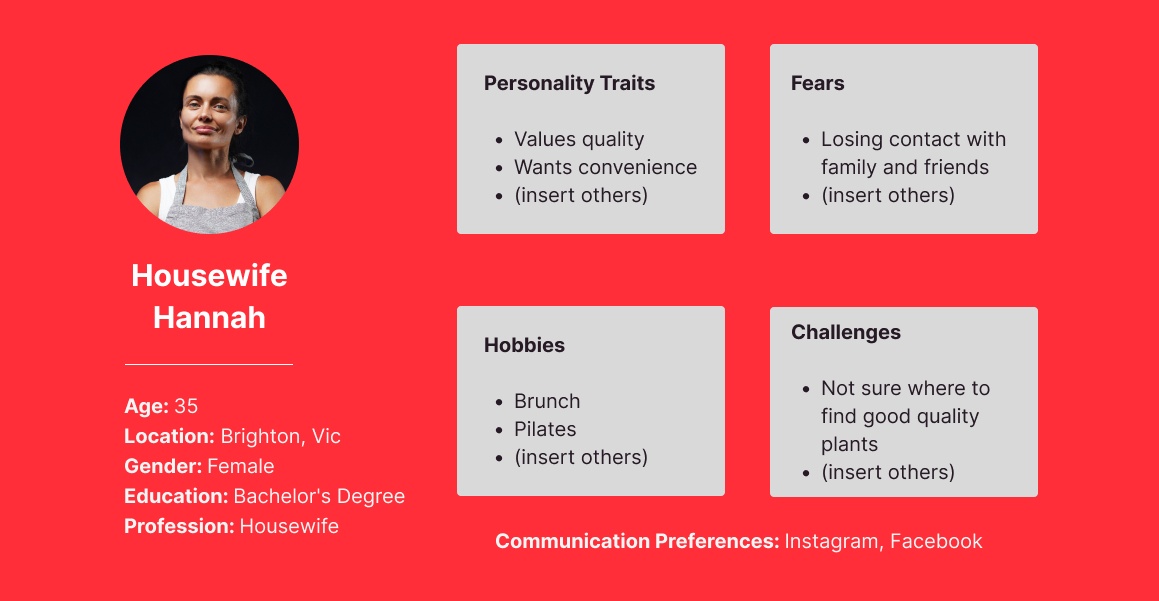- 15th December, 2023
- By Denise Choong
Exploring Customer Persona Development: How to Create Effective Customer Profiles for Targeted Marketing

One of the biggest mistakes you can make in business is trying to sell your product or service to everyone.
While it may be tempting to persuade every consumer on the planet to buy from you, not everyone will love your product, nor should they. Instead, savvy business owners and marketers understand that a focused and tactical approach is to sell your offerings to a specific group - thereby increasing your sales chances.
A customer persona is your champion in this. It’s a valuable reference point that helps your business stay focused on who you’re selling to and know how to target, support, and work with them.
But what is a customer persona? How does one go about creating one? Let’s take a look in detail.
What is a Customer Persona?
Customer persona, or ‘buyer persona’, is a detailed description of a customer who buys from your business. Often depicted in one page, marketers, business owners, and salespeople use this point-of-reference document to understand their target audience better.
Customer personas are also commonly known as target persona, marketing personas and audience personas for different marketing teams and businesses. It’s important to note that customer personas are fictional individuals developed based on your very real customers, and they should always be referred to when developing your marketing strategy.
Your customer personas are unique to your business and cannot be copied from a competitor - even if they are very similar. Developing a customer persona that works for your company requires plenty of research, patience, and time to complete successfully.
Most businesses would have from 2 to 4 different customer personas, as different customers can buy from your company for various reasons. The key is understanding these individuals and how they interact with your business - which brings us to our next point.
Why are Customer Personas important?
Customer personas are the foundation on which you base your marketing communications, assets, and copy. Here are some of their major benefits:

Creating a customer persona and aligning it to your business can make a major difference in your marketing efforts and overall revenue.
Customer Persona Examples
A customer persona should include names, interests, and behaviours. You can also add your target’s psychological traits, like goals, fears, and challenges.
Let’s look at two examples of customer personas for an online flower shop. If you’re the business owner, your primary customer persona could probably be ‘Housewife Hannah.’

Besides Housewife Hannah, the online flower shop can also develop other customer personas that buy flowers from their store. Let’s take a look at another profile that’s suitable in this case.

By using these profiles internally, the online flower shop’s business owner can begin to craft messages and develop marketing strategies according to the target audience.
Our Step-by-Step Guide to Developing Customer Personas
It takes time and research to build a detailed and fictional representation of your ideal customer. You can follow the steps below to develop your brand’s unique customer persona.
Step 1: Identify your target audience
It’s important to list your understanding of your customers, which can serve as a reference point for more research. Who are your customers currently? What do they look like?
This initial understanding of your target audience doesn’t have to be perfect, and it can be updated and changed once you’ve gathered more data.
Step 2: Gather data
The most crucial step in developing your customer persona is how you gather the information. You should speak to people who strongly understand who buys from your product and how they buy it. Here are some ways you can gather information:
- Conducting interviews with your existing customers
- Sending out surveys to potential and existing customers
- Speaking to front-facing employees in your business (i.e. salespeople and customer service representatives)
- Monitoring your social media or website for feedback and suggestions
- Conducting online polls on your social media platforms
Once you have gathered your information, it’s time to sort through them and make sense of your data.
Step 3: Sort through demographic and geographic information
Demographic and geographic information are the easiest ways to understand who your consumers are. These data are easier to sort through as they are generally the surface-level details you see about your customers.
To get started, sort your customers based on these characteristics and pick the biggest group that’s relevant to your business:
Age
Gender
Profession
Location (cities, towns, postcodes)
Income levels
Marital status
Education
Step 4: Analyse their psychology
Once you’ve selected your biggest group of consumers, it’s time to look at their psyche. Psychological characteristics go much deeper than what you see, involving their values, attitudes, and lifestyles.
Here are some psychological traits that you can use to build your customer persona:
Values and beliefs
Personality
Pain points
Motivators
Hobbies and interests
Wants and goals
Step 5: Understand their behaviour
What is their behaviour like when buying your product or any product in general? Understanding this vital part of how your consumers act helps you build an actionable customer persona for your next marketing strategy.
Here are some popular behavioural traits you can consider:
Buying behaviour (how often they buy)
Social media use
Mobile use
Media consumption
Product or brand knowledge
Price-sensitivity
Step 6: Create your persona
Once you have organised your customers into their geographic, demographic, psychographic, and behavioural traits, it’s time to add them to your customer persona. You can use the examples of customer personas above and adjust their categories to suit your brand.
Consider building other relevant personas that might use your products or services. Each persona is likely to buy for a different reason, and your marketing communications should reflect this.
Step 7: Refine and update
As your business grows, it’s important to stay agile and change your personas if necessary. Don’t get caught up thinking your persona will have the same hobbies and buying behaviours forever. Instead, monitor your customer sentiment to gauge if there’s anything new that your business can offer them.
Key Takeaway
Customer personas are necessary for a tactical marketing approach. With more understanding and research, you can tailor your communication, products, and website to engage your target audience effectively.
Digital Assassin works with Australian businesses to build effective websites based on thorough research of their customer persona. Our affordable web development plans include working with you in the development of your consumer persona and crafting targeted messaging that increases your website engagement.